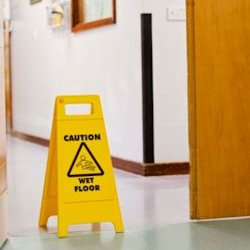Slips/Trips/Falls
Potential Hazards
The hazards that cause slips, trips, and falls include ergonomic stressors during handling, transferring and repositioning patients/residents, and environmental hazards.

Possible Solutions
In order to prevent slips, trips, and falls, effective equipment design (engineering controls) and safe work practices should be implemented. The engineering and work practice controls below can help in these efforts.
For more training on identifying and controlling hazards in the workplace go to your dashboard and check out OSHAcademy Course 153, Ergonomic Hazards in General Industry.
Slip, trip, and fall hazards include:
- slippery or wet floors
- uneven floor surfaces
- lifting in confined spaces
- cluttered or obstructed work areas/passageways
- poorly maintained walkway or broken equipment
- inadequate staffing levels to deal with the workload, leading to single person lifts and greater chances of falls
- inadequate lighting, especially during evening shifts
Engineering controls include:
- Removing uneven floor surfaces.
- Installing Non-slip surfaces in toilet/shower areas.
Safe work practices include:
- Immediately cleaning-up of fluids spilled on floor.
- Safely working in cramped working spaces by avoiding awkward positions and using equipment that makes lifts less awkward.
- Clearing cluttered or obstructed work areas.
- Asking for help when moving heavy patients.
Knowledge Check Choose the best answer for the question.
2-2. Immediately cleaning-up spilled fluids on floors is an example of _____.
You forgot to answer the question!
